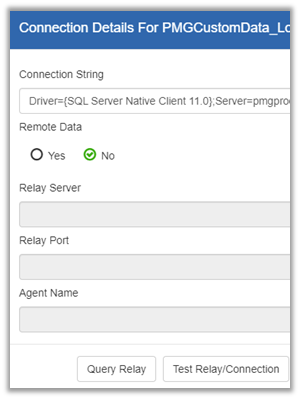# PMG Relay Framework
# Relay Framework Overview
The PMG Relay Framework is a solution which enables a PMG instance in one network to execute PMG workflows and PowerShell activities in a remote network and receive results. The framework is comprised of a stack of applications, services and workflow activities which support remote communications with configurable ports as well as support for web sockets which can significantly alleviate the need for firewall changes or VPN setup. Any number of remote network agents may connect to any number of "relay/listening service(s)" to support a many-to-many setup of remote agents and PMG Workflow instances.
There are three main components in the relay framework. The PMG “Workflow Engine”, which orchestrates the work to be done in PowerShell or a PMG Workflow Function on a network for which the engine cannot access. The PMG “Relay Service”, which provides a communications layer between the “Workflow Engine” and the “Remote PowerShell Agent”. “Remote Agent”, a service which runs on a computer within an isolated network, which will listen for commands to be ran from the “Workflow Engine”.
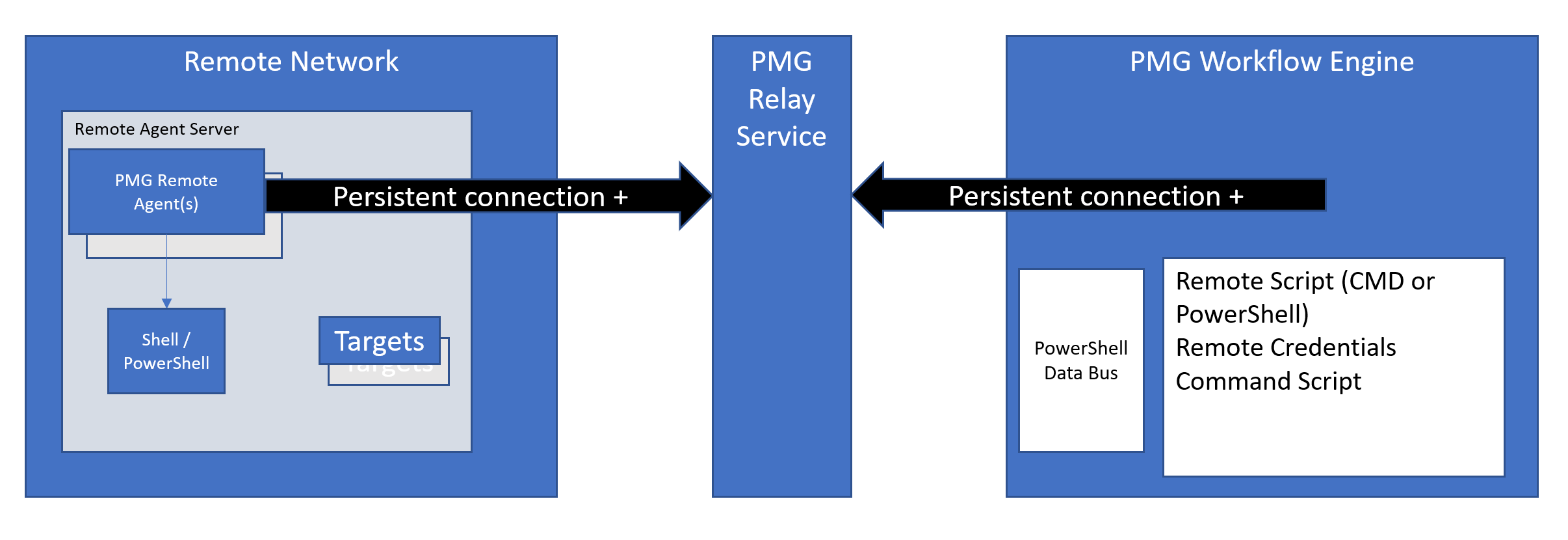
# Workflow Engine Remote PowerShell Action
The Remote PowerShell Action is used within a PMG workflow to specify the target agent and desired script to be executed. Credentials for the remote script are specified within the remote agent connection scenario. See Execution Scenario for details. Once connectivity is established, The PMG Workflow issues commands to the remote agents as needed.
* Persistent connections use WebSockets for connectivity. WebSocket connections can leverage proxy services, and agents must be installed to Windows 2012 or higher.
** The PowerShell Data Bus is a virtual data bus scoped to an executing workflow instance which allows for persistent storage of information between executing PowerShell scripts. See PMG PowerShell Remote Agent Cmdlets.
+ connections are encrypted with AES256 using configurable shared secret password. Network ports are configurable.
The PMG Relay Framework allows for communications between two isolated networks given the following. Network A, the target network, has no inbound or limited inbound communications available. Network A may also have limited outbound network traffic, firewalled to specific network port access, or outbound access granted only by a proxy service.
However, given Network A can communicate outbound via proxy or firewall, the PMG Relay Service allows the PMG Workflow Engine, from Network B, the source network, to send commands to be executed to the target environment.
In this case, to execute PowerShell within the remote network, the PMG Remote Agent will need to be deployed and configured to establish an outbound "channel" connection request to the PMG Relay Service. The remote agent will register itself with a unique identifier, typically the machine name. The agent identifier, or "agent name" will be used by the PMG Workflow Engine to specify the target for the remote commands. Commands are sent to the PMG relay service which then forwards the commands to the listening matching agents.
The remote agent will keep its connection open as well as implement a "keep alive" and a "connection refresh" process. The connection will be used for the agent to listen for new commands from the "relay service".
A Remote PowerShell action will attempt to connect to the relay server synchronously to transmit the request. The relay service will receive the request and look for a matching registered remote agent name. If no match is found, the action will follow out "Remote agent not found".
If a matching agent is registered with the relay service, the service will transmit the request to the agent. The remote agent will attempt to execute the request synchronously and its response will be sent to the relay service, to be transmitted back to the originating workflow engine.
# PMG Relay Framework Requirements
The below provides requirements for the components of the PMG Relay Framework
# Remote Agent
Remote Agents may be installed to Window Server 2012 or higher, with PowerShell 5.1 or higher. Remote Agents may also be installed to Linux with PowerShell Core 2 or higher. Windows Management Framework 5.1 or higher may be required on Windows Server versions prior to 2016. See WMF 5.1 at https://go.microsoft.com/fwlink/?linkid=839460
The remote agent server requires network or proxy access to the PMG Relay Service. Proxies must support WebSockets.
# PMG Relay Service
Windows Server 2012 or higher with IIS. May optionally be deployed on one or more PMG Portal instances. The relay service must be network accessible to both the Remote Agent and the PMG Workflow Engine server.
# PMG Workflow Engine / Remote PowerShell Action
The PMG Workflow engine requires network or proxy access to the PMG Relay Service. Proxies must support WebSockets.
# Remote Agent and Relay Service Installation
The below instructions apply to installation of each feature, the Remote Agent and the Relay Service
Run the WorkflowRemoteAgent.exe file to extract its contents to a specified folder.
Select the extraction path and click OK. Note: The default extract path is C:\Program Files\PMG Service Catalog\WorkflowRemoteAgent\
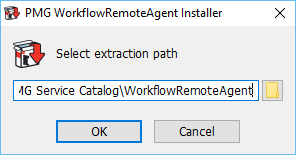
- Run the program RelayAgentConfigGUI.exe in the extract folder selected
Note: Once configured, the Relay and Agent services are accessible as needed as an installed Windows Service.

# Agent/Relay Settings
To configure the machine as an Agent, check “Enable Agent” and provide the following.
Agent Name: a unique name for the agent, which will be referenced from a workflow.
Replay IP: the machine name or IP address of the Relay Service server
Agent Port: the Agent Port to use when connecting to the Relay Server. Note: Workflow Port is ignored for Remote Agents.
If the agent requires a proxy to connect to the relay server, provide values for “Agent Proxy Settings”
Server: the Proxy Server for the outbound connection
Port: the Proxy Server port to use
User/Domain/Password: optional user information for the proxy server access
To finalize the Agent configuration, Click “Apply” button to save configuration then “Start Services” to start the PMG Remote Agent Service
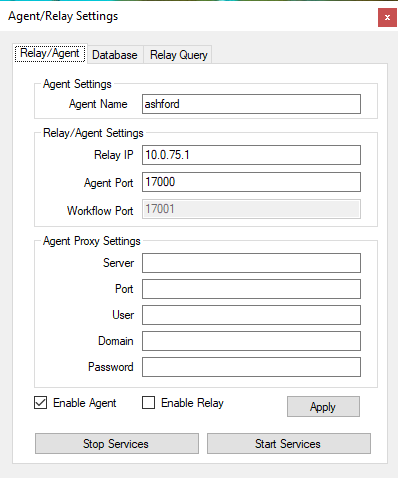
To configure the machine as a Relay, check “Enable Relay” and provide the following.
Relay IP: the Relay IP for the Relay Service to bind for listening
Agent Port: the Agent Port which the Relay Service will listen for remote Agent connections
Workflow Port: the Workflow Port which is the IP port the Relay Service will listen for PMG Workflow connections
WebSocket Proxy Settings are ignored for the Relay Service
Click “Apply” to save the configuration, then click “Start Services” to start the PMG Relay Service
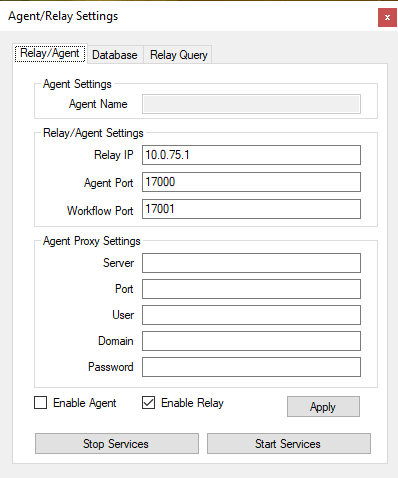
# Remote Workflow Support
The Database tab of the configuration application is required to execute workflows
Provide values as needed to communicate with the PMG database and click “Update”
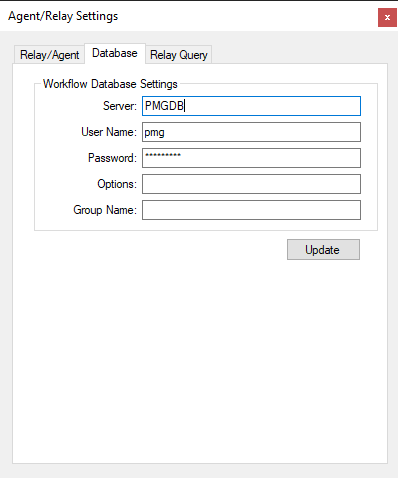
# Connection Diagnostics
The Relay Query tab provides diagnostic information for the configured services. Click “Query” to receive information about the connection.
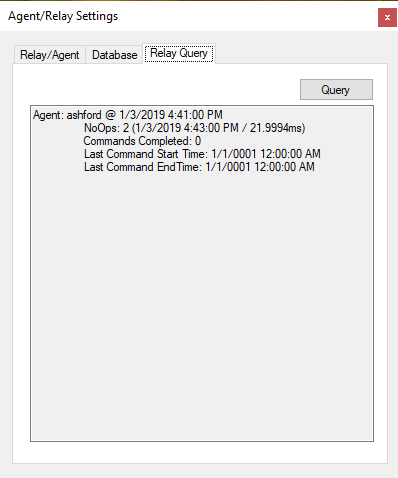
# Remote Agents
Remote agents are available in two forms, as PowerShell agents and Workflow Function agents. The PMG Remote PowerShell agent operates as lightweight specialized software package which can listen for and execute PowerShell with various security contexts, and in parallel execution. The PMG Workflow Function Agent is an instance of a PMG Workflow Server configured to listen for workflow functions to be executed and return results. PowerShell agents are available for Windows and Linux with PowerShell Core.
The “Remote Agent” is a service which listens for PowerShell commands (Windows or Linux) or Workflow Functions (Windows) to be ran on the agent. Commands can be local to the specified computer or outbound to another computer or application.
# Relay Service
The Relay Service runs as a Windows Service and can be deployed independently or within another PMG application server. The PMG Workflow Engine and Remote Agents communicate with the Relay Server by available Proxy services or through configured TCP ports.
When an agent connects, the agent registers with its configured instance name. See Remote Agent Configuration for details. This agent instance name will subsequently be used by the PMG Workflow Engine as the requested “Scenario” by either the Remote PowerShell Action or Remote Workflow Action.
# High Availability
The framework supports a high availability configuration to allow for resilience and uptime, while also enabling the removal of instances from the pool in order to perform any system maintenance. See the Execution Scenario information for how to specify a pool of relay servers and a pool of agents.
When stopping an agent service or a relay service, the service will attempt to allow any current processes to complete. This allows individual relays or agents to be removed from a group or farm as needed.
# Remote PowerShell Action Usage
# Remote PowerShell

PMG Workflow offers the “Remote PowerShell” action to initiate PowerShell commands to remote registered agents.
The action is found under the Integration category in the actions palette. The action properties are as follows.
Name
Provides for a friendly custom name for the action within the diagram
Label
Provides for an additional text label for the action within the diagram
Run Mode
This setting determines how the PowerShell will be executed.
New Process: The PowerShell will run within a separate execution scope, with the security context of the running service
New Process (As User): The PowerShell will run in as the user identity specified in the given scenario
Execution Scenario
Specifies the execution scenario, managed from the Designer Menu Bar, Manage, Connector Configuration, ExecuteAs.Config.xml.
An example scenario is below.
<actionconfig>
<scenario name="machineA">
<!-- name:Specifies the name of the scenario to be used by the workflow action -->
<relayServerCommMode>WebSocket</relayServerCommMode>
<!-- Specifies the communications mode for the relay. If the node value is WebSocket, then WebSockets will be used for the connection. Otherwise, standard TcpClient is used. -->
<useRelayServer>true</useRelayServer>
<!-- When the node is “true”, specifies the connection will use a Relay Server, or if “false” or not present, then a direct TCP connection will be made. -->
<proxyServer /><!-- Optional proxy server machine name or IP address -->
<proxyPort /><!-- Optional proxy port to use -->
<proxyUser /><!-- Optional proxy user if credentials are required -->
<proxyDomain /><!-- Optional user domain for credentials if required -->
<proxyPassword /><!-- Optional proxy password if required -->
<relayConfig>
<!-- NOTE: Multiple relayConfig nodes may be defined to specify a list of relays to try.This node specifies attributes for the relay server -->
<ip>127.0.0.1</ip><!-- Specifies the machine name or IP address of the relay server -->
<workflowPort>17001</workflowPort><!-- Specifies the network port of the Workflow Engine -->
<retryDelayMs>1000</retryDelayMs><!-- Optional delay in milliseconds to retry a communication request -->
<agentWaitMs>30000</agentWaitMs>
<!-- Optional time in milliseconds to wait for a remote command to execute -->
</relayConfig>
<agentName>machineA</agentName>
<!-- NOTE: multiple agentName nodes may be specified to establish a pool of agents to try to send commands -->
<domain>DOMAIN</domain><!-- The domain name for the user to authenticate for the remote command -->
<username>USERNAME</username><!-- The username to authenticate the remote command -->
<password note="thisIsMethod2">Q…AA==</password>
<!--The password of the remote user to authenticate the remote command -->
<waitseconds>600</waitseconds>
<!--The time to wait in seconds for the command to execute. -->
<certName>Workflow Remote Agent Server</certName>
<!-- The name of the certificate to be used when using TcpClient. The cert must be installed in the Personal folder for the local machine -->
<authKey>qi…m</authKey> <!-- a shared secret key -->
</scenario>
<actionconfig>
Script
The Script property contains the script to run on the remote server. The editor provides a PowerShell syntax aware editor as below. The script supports accessing and setting PMG workflow variables, which then effectively provides a PowerShell data bus for any scripts ran within the workflow.

Variable for Information
Optional string variable to capture “Information” level pipeline details
Variable for Error
Optional string variable to capture “Error” level pipeline details
Action Outputs
This action will output one of the following
Successful – The remote PowerShell or action was able to execute (with or without PowerShell script errors)
Unsuccessful – The Relay Framework encountered some issue in attempting to transmit or receive the information for the requested PowerShell script.
Agent Not Found – The Relay Framework did not find a matching agent available to process the requested PowerShell script
# PMG variables and PowerShell variables
PMG variables and PowerShell variables may be used interchangeably within the defined script. In the example above, a PMG variable $RemoteCounter is referenced and modified within the script. This updated value will become the new value of $RemoteCounter within the PMG workflow on completion of this action execution. The updated value can then be referenced later within the same workflow, as well as be referenced in a subsequent Remote PowerShell action.
Remote PowerShell may also leverage encrypted Environment Values.
# PMG PowerShell Cmdlets
The PMG Remote Agent makes the following cmdlets available.
# Get-PMGSecureString – NOTE: This cmdlet is flagged for deprecation. Please use encrypted Environment Variables as the alternative. See [Securing Credentials](#Securing Credentials) for Remote PowerShell usage
# Add-PMGStepDetail
This cmdlet will log information back to the executing action step details
An example test script is below.
Add-PMGStepDetail -Message "some stuff!"
# PMG PowerShell Cmdlets - deprecated
NOTE: The following PMG PowerShell Cmdlets are deprecated and are replaced with inline variable access.
The PMG Remote Agent is installed with PowerShell cmdlets which support the getting and putting of values into PMG workflow variables.
Get-PMGVariable -name
This cmdlet will load a variable value from the PMG workflow instance
Set-PMGVariable
This cmdlet will set a value back to a PMG workflow variable
# Securing credentials for Local and Remote PowerShell usage
Values may be stored encrypted and secured locally, within the PMG application and then made available for access to local and remote PowerShell execution.
To secure data for PowerShell, follow the below steps.
- Define an environment value using the "Encrypt" feature.

- To further secure a value for PowerShell, you may limit which workflows can access the environment value using the "Change associated workflows" setting for the value.

An encrypted and limited environment value will appear as below in the Environment Values screen.

- To access the secured value from PowerShell, refer to the value as a variable using $ASecuredValue, based on the example above.
# Legacy Method
Note: This below method is deprecated. Please use encrypted Environment Values instead.
To use a secure string with the Get-PMGSecureString cmdlet in the the PowerShell action, follow the below steps.
The Get-PMGSecureString requires a connector configuration to access encrypted data. To create a new secure string, From the PMG Workflow Designer, navigate to the Connector Configuration utility.
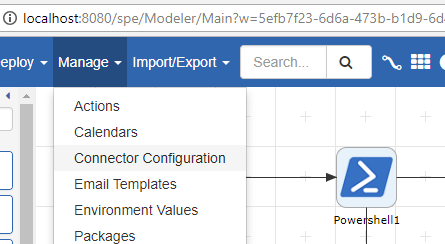
If PowerShell.Config.xml is available in the connector configuration dropdown, skip to the PowerShell.Config.XML example. Otherwise, to create a new Connector Configuration, click new.
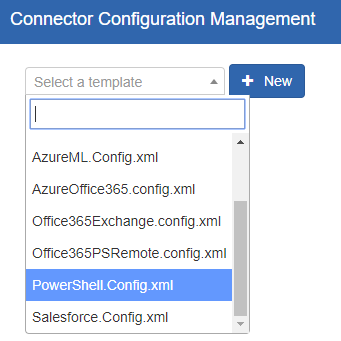
Create a configuration with the name “PowerShell.Config.xml”

# PowerShell.Config.XML example
Add the XML below to your configuration. Proceed to step 6.
<powershell>
<securedata> <data name="{{name}}">
<workflows>
<workflow>{{workflowname}}</workflow>
</workflows>
<securestring>{{__method2_encrypted_data__}}</securestring>
</data> </securedata>
</powershell>
To add more secure string options to your configuration add a repeating data node.
<powershell>
<securedata>
<data name="MyPassword">
<workflows>
<workflow>PS_GetAccounts</workflow>
<workflow>PS_SecureString</workflow>
</workflows>
<securestring>AwC0AM8AICAXADMAXgB9AEIAQQALAA/AAEAYAH</securestring>
</data>
<data name="{{name}}">
<workflows>
<workflow>{{workflowname}}</workflow>
</workflows>
<securestring>{{__method2_encrypted_data__}}</securestring>
</data>
</securedata>
</powershell>
Replace with the name you’d like to use to refer to your secure string, such as AzurePassword.
Replace with the name of the workflow you’d like to have access to this data. More workflow nodes can be added to use this secure string in other workflows.
<workflows>
<workflow>{{workflowname1}}</workflow>
<workflow>{{workflowname2}}</workflow>
</workflows>
Replace
{{__method2_encrypted_data__}}
with the encrypted data you’d like to use as your secure string. Use PMG’s method 2 to perform the encryption.
Click “Save” at the bottom right of the window.
This data can now be used in the PowerShell action’s PowerShell Script property.
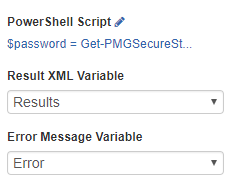
You can refer to this data in the PowerShell Script property as shown below.
$password = Get-PMGSecureString -name MyPassword
$UserCredential = New-Object System.Management.Automation.PSCredential ("bob@bob.com", $password)
Login-AzureRmAccount -Credential $UserCredential
This data is retrieved with the Get-PMGSecureString cmdlet. Refer to the data you want with the name you provided in the PowerShell.Config.XML above
# Remote Workflow Action

The Remote Workflow Action leverages the PMG Relay Framework to execute a workflow function from a configured Remote Workflow Agent. To “pass” or “receive” data in the remote workflow, use variables of the same name in both workflows. If both workflows have a string variable named, “MyString”, and the calling workflow sets MyString to “Are You There”, then that value will be automatically available in the called workflow function in the variable of the same name. The called workflow function can then change the value, to “Yes” which would then be available to the calling workflow.
NOTE: This action requires access to the application database.
The action provides the following properties.
Scenario – This determines the remote agent name which will execute the workflow function. Scenarios are defined within the ExecuteAs.Config.xml connector configuration.
Workflow – Specifies the workflow name to be executed
Use as Synch Result – Determines if the output of the called workflow function will be used as the synchronous result of the calling workflow
Send Content XML – Determines whether the contents of the calling workflow will be used as the contents of the remote invoked workflow function
# External Data Sources over Relay Framework
The Relay Framework supports connectivity to external data sources. The PMG Platform is able to query external data sources through the agents which have access to the given data source. As an example, this connectivity provides access of a cloud hosted PMG instance to query data sources which are located behind a corporate firewall on a private network. To enable this feature, see the setting ENABLE_REMOTE_DATA_SOURCES. Once enabled, forms, apps, workflows, reports, etc. may access the remote data source.
With the feature enabled, there is a new setting configuration for "External Data Sources" to set the Remote Data properties.
